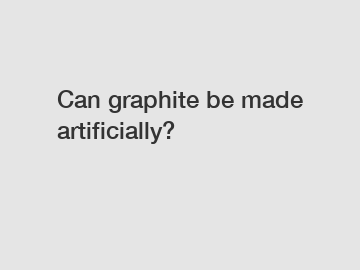Can graphite be made artificially?
For more information, please visit Hengjingming.
Can graphite be made artificially? The answer is yes. Graphite, a form of carbon, can be artificially manufactured through a process called graphitization. Graphitization involves heating carbon materials, such as petroleum coke or coal tar pitch, to extreme temperatures in a controlled environment. This process converts the carbon atoms into a crystalline structure, resulting in the formation of graphite.
The concept of artificially manufacturing graphite was first discovered by Edward Goodrich Acheson in 1890. Acheson accidentally stumbled upon this method while trying to produce artificial diamonds. He heated a mixture of clay and coke in an electric furnace and observed that a substance was forming on the carbon electrodes. This substance turned out to be graphite. Acheson's accidental discovery revolutionized the production of graphite and opened up numerous possibilities for its industrial applications.

The process of graphitization involves several steps. First, the carbon materials are crushed and mixed with a binder to form a paste. This paste is then shaped into the desired form, such as rods or blocks. These shaped carbon materials are then heated in a furnace at temperatures ranging from 2500 to 3000 degrees Celsius. This high temperature causes the carbon atoms to rearrange and form layers of hexagonal structures, which give graphite its characteristic properties.
The artificially manufactured graphite has several advantages over natural graphite. One significant advantage is the ability to tailor its properties to meet specific requirements. By modifying the graphitization process parameters, such as temperature and heating time, engineers can control the size and arrangement of the graphite crystals, which in turn affects its thermal and electrical conductivity, strength, and lubricity. This control over the properties of artificially made graphite expands its applications in various industries.
The widespread availability and lower cost of artificially made graphite have also made it a preferable choice for many applications. Natural graphite deposits are limited, and their extraction and purification processes can be environmentally damaging. By manufacturing graphite artificially, the reliance on natural resources can be reduced, and the environmental impact minimized.
In conclusion, graphite can indeed be made artificially through a process called graphitization. Edward Goodrich Acheson's accidental discovery in 1890 paved the way for the industrial production of graphite. The ability to control the properties of artificially made graphite and its widespread availability have revolutionized various industries, ranging from batteries and fuel cells to lubricants and electronic devices. This artificial graphite has not only expanded the possibilities for technological advancements but also offers a more sustainable and environmentally friendly alternative to natural graphite.
For more information, please visit our website.
Are you interested in learning more about petroleum coke carburizing agent manufacturers? Contact us today to secure an expert consultation!



